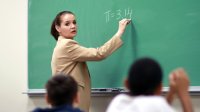New Teachers: How to Develop ‘The Look’
Check out this effective, nonverbal tactic for managing students without calling anyone out in front of the class.
While taking teacher preparation courses, I was lucky enough to sign up for a class with Dr. Sharroky Hollie, author of the book Culturally and Linguistically Responsive Teaching and Learning.
The course was on classroom management, specifically for new teachers working in urban public schools. There are several things that really stuck with me from the class, and they have stayed with me all these years. For one, Dr. Hollie brought in a community member to talk to us about gangs and the history of gangs in Los Angeles. We also learned about tagging (the messages it sends and its purposes), as well as reasons behind kids being drawn into this life.
We were taught the importance of always having an activity during those crucial first minutes of class, and for Dr. Hollie, it was silent reading. Each class, we were to bring something to read, and we would all spend the first 10 minutes reading silently and share after with a neighbor what we had just read. Some of us would forget to bring a book, newspaper, or magazine (before cellphones), and it was embarrassing. I realized later that the partial intention of this activity was to show us that, hey, we all forget sometimes (to bring a book, homework, a pencil, etc.). The other more obvious and important reason was to see the value in this activity and to use it with our students to nurture a love for independent reading.
Learning The Look
As for the most memorable of his lessons? At the beginning of one of our earlier classes, Dr. Hollie asked us if we all had The Look down yet. Most of us glanced around, confused, not sure what he meant (we were all first-year teachers). A few students understood, nodding. He then explained that it’s essential that every effective teacher develop The Look.
He told us that this facial expression serves as a nonverbal signal to a child that you see that they are off task and talking or doing something they shouldn’t be doing (e.g., chewing gum or trying to distract another student who is trying to complete an assignment).
Dr. Hollie said that, if done correctly, The Look silently conveys a serious warning, and it’s a great tactic for managing without calling a student out in front of the class. The Look should not be mean or angry; in fact, it can convey calm and is often free of any expression.
He then had us practice in groups of four or five. After much laughter and dramatics in our groups, he asked us to come to the front of the room and at the count of three, all do The Look we had created. The rest of the class would comment, critique, clap, and then give each group a grade: Definitely a B+. No, I’d say it was a B- because someone laughed!
It was a fun activity and very informative. I realized after that day and throughout my first year teaching that many occasions arise in the classroom when we can use this tactic (and other nonverbal ones) to signal to students that we are cognizant of their behavior. Sometimes situations do not warrant words—mere eye contact or going to stand next to where a student is seated will do. Nonverbal classroom management tactics like these help keep everyone’s dignity intact in the room, as calling out students’ behaviors in front of the class can be embarrassing for the child. (That conversation is better and more effective one-on-one with the student once the bell rings.)
Does It Work?
Over the years I taught high school English, I had a number of students comment to me about The Look. They told me they would consciously avoid doing things that might get it sent their way. They understood that it was something I didn’t do often, but when I did, the reason was serious and the student was not going unseen—he or she was accountable.
To new teachers: Now is the time to practice. Do so with a colleague and take turns. Coach each other, and also practice in the mirror and fine-tune an expression that conveys this idea: “I see you. I’m on your side, but you know what the task at hand is.”
What nonverbal (or verbal) classroom management tactics do you find helpful that you can suggest to novice teachers? Please share in the comments section below.
